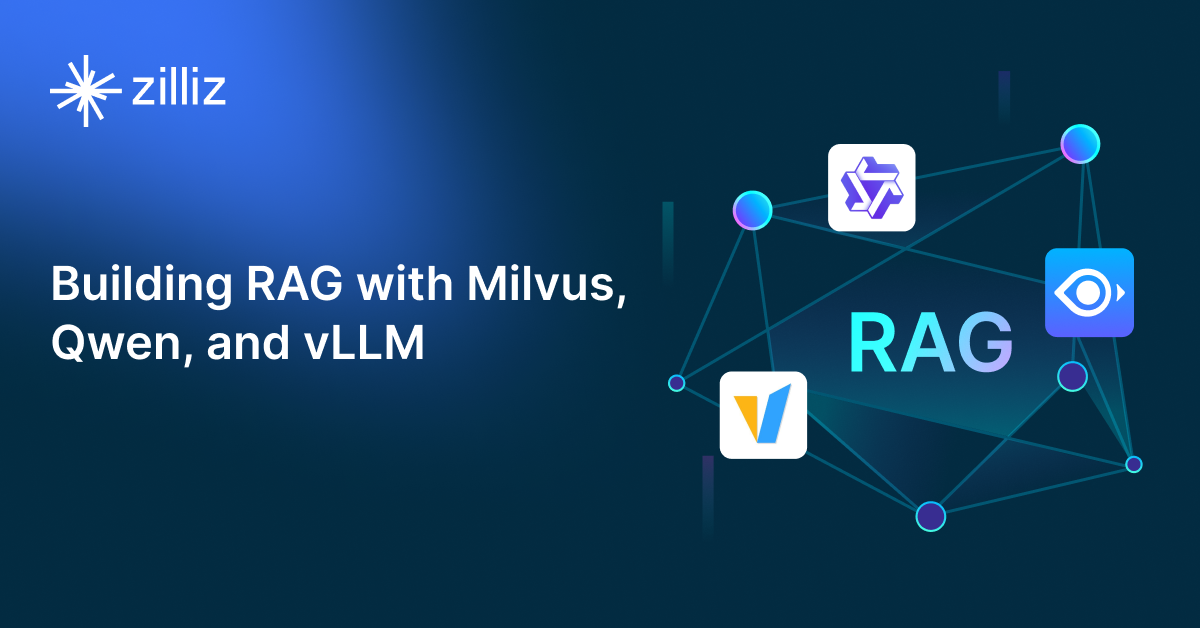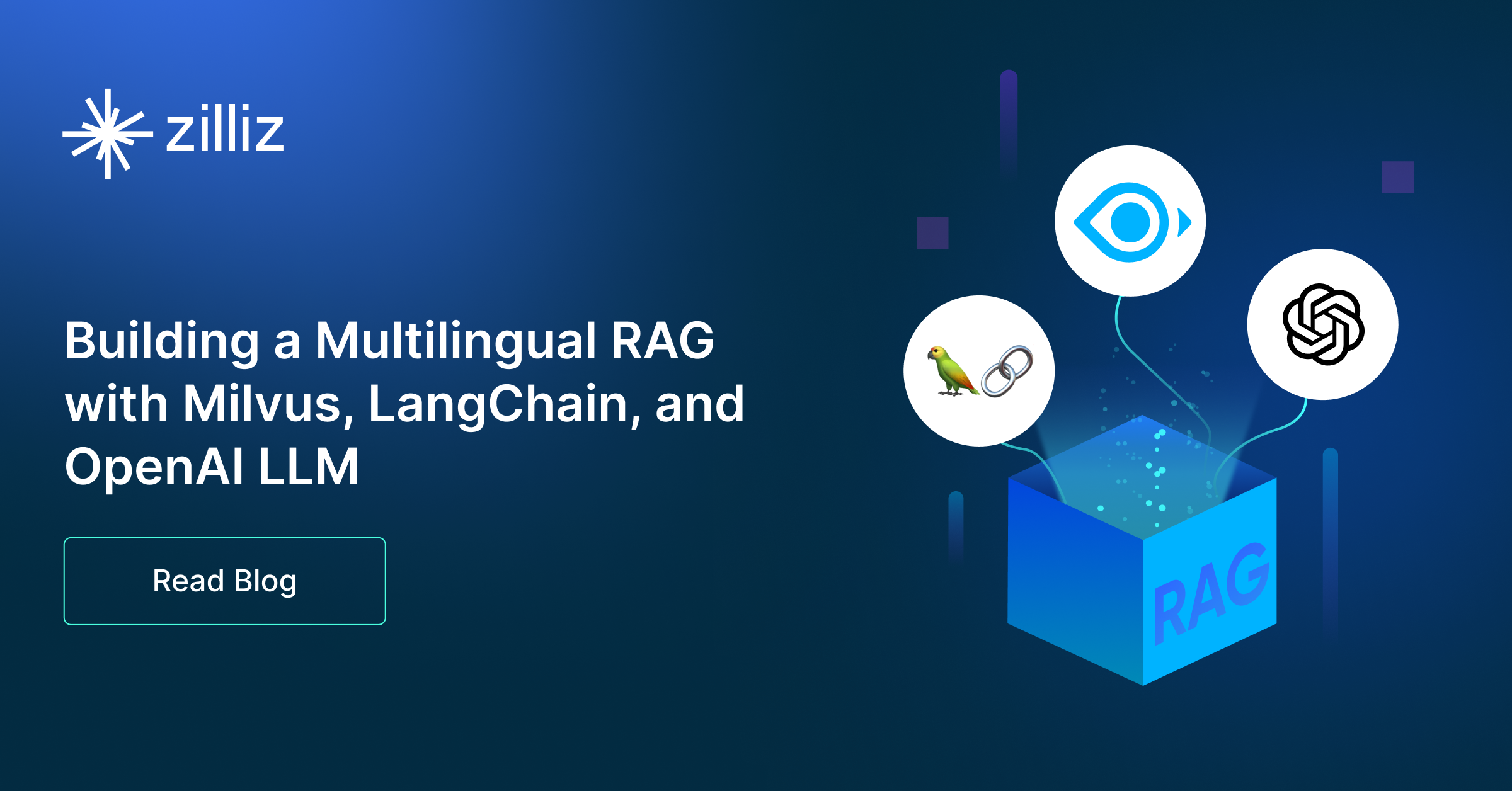Build RAG Chatbot with LangChain, pgvector, Anthropic Claude 3 Opus, and IBM slate-125m-english-rtrvr
Introduction to RAG
Retrieval-Augmented Generation (RAG) is a game-changer for GenAI applications, especially in conversational AI. It combines the power of pre-trained large language models (LLMs) like OpenAI’s GPT with external knowledge sources stored in vector databases such as Milvus and Zilliz Cloud, allowing for more accurate, contextually relevant, and up-to-date response generation. A RAG pipeline usually consists of four basic components: a vector database, an embedding model, an LLM, and a framework.
Key Components We'll Use for This RAG Chatbot
This tutorial shows you how to build a simple RAG chatbot in Python using the following components:
- LangChain: An open-source framework that helps you orchestrate the interaction between LLMs, vector stores, embedding models, etc, making it easier to integrate a RAG pipeline.
- Pgvector: an open-source extension for PostgreSQL that enables efficient storage and querying of high-dimensional vector data, essential for machine learning and AI applications. Designed to handle embeddings, it supports fast approximate nearest neighbor (ANN) searches using algorithms like HNSW and IVFFlat. Since it is just a vector search add-on to traditional search rather than a purpose-built vector database, it lacks scalability and availability and many other advanced features required by enterprise-level applications. Therefore, if you prefer a much more scalable solution or hate to manage your own infrastructure, we recommend using Zilliz Cloud, which is a fully managed vector database service built on the open-source Milvus and offers a free tier supporting up to 1 million vectors.)
- Anthropic Claude 3 Opus: This advanced model in the Claude 3 series is designed for complex reasoning and nuanced conversations. It combines deep understanding with ethical considerations, making it ideal for sensitive applications like customer support, therapy chatbots, and content generation where context and empathy are paramount.
- IBM slate-125m-english-rtrvr: This model is designed for fine-tuning English text retrieval tasks, leveraging a slim and efficient architecture. Its strength lies in fast processing and high accuracy, making it ideal for applications that require quick and relevant information retrieval from large text datasets. Use cases include document search engines, chatbots, and content recommendation systems.
By the end of this tutorial, you’ll have a functional chatbot capable of answering questions based on a custom knowledge base.
Note: Since we may use proprietary models in our tutorials, make sure you have the required API key beforehand.
Step 1: Install and Set Up LangChain
%pip install --quiet --upgrade langchain-text-splitters langchain-community langgraph
Step 2: Install and Set Up Anthropic Claude 3 Opus
pip install -qU "langchain[anthropic]"
import getpass
import os
if not os.environ.get("ANTHROPIC_API_KEY"):
os.environ["ANTHROPIC_API_KEY"] = getpass.getpass("Enter API key for Anthropic: ")
from langchain.chat_models import init_chat_model
llm = init_chat_model("claude-3-opus-latest", model_provider="anthropic")
Step 3: Install and Set Up IBM slate-125m-english-rtrvr
pip install -qU langchain-ibm
import getpass
import os
if not os.environ.get("WATSONX_APIKEY"):
os.environ["WATSONX_APIKEY"] = getpass.getpass("Enter API key for IBM watsonx: ")
from langchain_ibm import WatsonxEmbeddings
embeddings = WatsonxEmbeddings(
model_id="ibm/slate-125m-english-rtrvr",
url="https://us-south.ml.cloud.ibm.com",
project_id="<WATSONX PROJECT_ID>",
)
Step 4: Install and Set Up pgvector
pip install -qU langchain-postgres
from langchain_postgres import PGVector
vector_store = PGVector(
embeddings=embeddings,
collection_name="my_docs",
connection="postgresql+psycopg://...",
)
Step 5: Build a RAG Chatbot
Now that you’ve set up all components, let’s start to build a simple chatbot. We’ll use the Milvus introduction doc as a private knowledge base. You can replace it with your own dataset to customize your RAG chatbot.
import bs4
from langchain import hub
from langchain_community.document_loaders import WebBaseLoader
from langchain_core.documents import Document
from langchain_text_splitters import RecursiveCharacterTextSplitter
from langgraph.graph import START, StateGraph
from typing_extensions import List, TypedDict
# Load and chunk contents of the blog
loader = WebBaseLoader(
web_paths=("https://milvus.io/docs/overview.md",),
bs_kwargs=dict(
parse_only=bs4.SoupStrainer(
class_=("doc-style doc-post-content")
)
),
)
docs = loader.load()
text_splitter = RecursiveCharacterTextSplitter(chunk_size=1000, chunk_overlap=200)
all_splits = text_splitter.split_documents(docs)
# Index chunks
_ = vector_store.add_documents(documents=all_splits)
# Define prompt for question-answering
prompt = hub.pull("rlm/rag-prompt")
# Define state for application
class State(TypedDict):
question: str
context: List[Document]
answer: str
# Define application steps
def retrieve(state: State):
retrieved_docs = vector_store.similarity_search(state["question"])
return {"context": retrieved_docs}
def generate(state: State):
docs_content = "\n\n".join(doc.page_content for doc in state["context"])
messages = prompt.invoke({"question": state["question"], "context": docs_content})
response = llm.invoke(messages)
return {"answer": response.content}
# Compile application and test
graph_builder = StateGraph(State).add_sequence([retrieve, generate])
graph_builder.add_edge(START, "retrieve")
graph = graph_builder.compile()
Test the Chatbot
Yeah! You've built your own chatbot. Let's ask the chatbot a question.
response = graph.invoke({"question": "What data types does Milvus support?"})
print(response["answer"])
Example Output
Milvus supports various data types including sparse vectors, binary vectors, JSON, and arrays. Additionally, it handles common numerical and character types, making it versatile for different data modeling needs. This allows users to manage unstructured or multi-modal data efficiently.
Optimization Tips
As you build your RAG system, optimization is key to ensuring peak performance and efficiency. While setting up the components is an essential first step, fine-tuning each one will help you create a solution that works even better and scales seamlessly. In this section, we’ll share some practical tips for optimizing all these components, giving you the edge to build smarter, faster, and more responsive RAG applications.
LangChain optimization tips
To optimize LangChain, focus on minimizing redundant operations in your workflow by structuring your chains and agents efficiently. Use caching to avoid repeated computations, speeding up your system, and experiment with modular design to ensure that components like models or databases can be easily swapped out. This will provide both flexibility and efficiency, allowing you to quickly scale your system without unnecessary delays or complications.
pgvector optimization tips
To optimize pgvector in a Retrieval-Augmented Generation (RAG) setup, consider indexing your vectors using GiST or IVFFlat to significantly speed up search queries and improve retrieval performance. Make sure to leverage parallelization for query execution, allowing multiple queries to be processed simultaneously, especially for large datasets. Optimize memory usage by tuning the vector storage size and using compressed embeddings where possible. To further enhance query speed, implement pre-filtering techniques to narrow down search space before querying. Regularly rebuild indexes to ensure they are up to date with any new data. Fine-tune vectorization models to reduce dimensionality without sacrificing accuracy, thus improving both storage efficiency and retrieval times. Finally, manage resource allocation carefully, utilizing horizontal scaling for larger datasets and offloading intensive operations to dedicated processing units to maintain responsiveness during high-traffic periods.
Anthropic Claude 3 Opus optimization tips
Claude 3 Opus is a powerful model for RAG applications requiring deep reasoning and high-quality responses. Optimize performance by structuring retrieval results effectively, ensuring that only the most relevant context is provided to avoid unnecessary token usage. Utilize a ranker to prioritize key passages before sending them to the model, preventing information overload and improving response quality. Fine-tune hyperparameters like temperature (0.1–0.3 for factual tasks) and top-k sampling to maintain accuracy while controlling response variation. If cost and speed are concerns, use Claude 3 Opus selectively for complex queries while relying on a smaller model like Claude 3 Haiku for simpler tasks. Implement caching for repeated or high-frequency queries to minimize API calls and improve latency. Use Claude’s parallel processing capabilities where applicable to handle multiple document queries efficiently.
IBM slate-125m-english-rtrvr optimization tips
To optimize the IBM slate-125m-english-rtrvr for Retrieval-Augmented Generation (RAG), ensure that your document retrieval system is fine-tuned with domain-specific data to improve relevance. Utilize embeddings effectively by implementing cosine similarity for efficient nearest neighbor searches, and consider applying caching mechanisms to store frequently accessed documents. Additionally, experiment with various query augmentation techniques, like rephrasing or adding related keywords, to enhance retrieval performance. Monitor and analyze retrieval metrics (such as precision and recall) to iteratively refine your setup, and if possible, implement an ensemble approach by integrating multiple retrieval models to boost diversity in retrieved content. Finally, regularly update your corpus to reflect current knowledge and trends.
By implementing these tips across your components, you'll be able to enhance the performance and functionality of your RAG system, ensuring it’s optimized for both speed and accuracy. Keep testing, iterating, and refining your setup to stay ahead in the ever-evolving world of AI development.
RAG Cost Calculator: A Free Tool to Calculate Your Cost in Seconds
Estimating the cost of a Retrieval-Augmented Generation (RAG) pipeline involves analyzing expenses across vector storage, compute resources, and API usage. Key cost drivers include vector database queries, embedding generation, and LLM inference.
RAG Cost Calculator is a free tool that quickly estimates the cost of building a RAG pipeline, including chunking, embedding, vector storage/search, and LLM generation. It also helps you identify cost-saving opportunities and achieve up to 10x cost reduction on vector databases with the serverless option.
 Calculate your RAG cost
Calculate your RAG cost
What Have You Learned?
By diving into this tutorial, you’ve unlocked the power of combining cutting-edge tools to build a RAG system from the ground up! You learned how LangChain acts as the glue, seamlessly orchestrating workflows between components like a pro. With pgvector, you transformed PostgreSQL into a high-performance vector database, mastering how to store, index, and retrieve embeddings at scale. The IBM slate-125m-english-rtrvr embedding model became your secret weapon, converting text into rich numerical representations that capture meaning and context. And then came the star of the show: Anthropic Claude 3 Opus, whose advanced reasoning skills turned retrieved data into coherent, insightful responses. Together, these pieces formed a dynamic pipeline where LangChain directs the flow, pgvector fetches relevant context, IBM’s embeddings make sense of unstructured data, and Claude 3 Opus crafts answers that feel almost human. You even picked up pro tips for optimizing speed and accuracy, like tweaking chunk sizes and balancing recall vs. latency—plus, that free RAG cost calculator gave you a practical edge in budgeting your projects.
Now you’re equipped to build RAG systems that don’t just work but thrive in real-world scenarios. Imagine the applications: smarter chatbots, research assistants that dig deeper, or tools that surface insights from mountains of data. The best part? You’ve got the tools and knowledge to experiment fearlessly. Tweak parameters, swap models, or layer in new data sources—your creativity is the limit. So go ahead! Fire up your IDE, spin up a database, and let LangChain handle the heavy lifting. Every line of code you write brings us closer to AI that’s more intuitive, helpful, and downright magical. The future of intelligent applications is yours to shape—start building, keep iterating, and watch your ideas come alive! 🚀
Further Resources
🌟 In addition to this RAG tutorial, unleash your full potential with these incredible resources to level up your RAG skills.
- How to Build a Multimodal RAG | Documentation
- How to Enhance the Performance of Your RAG Pipeline
- Graph RAG with Milvus | Documentation
- How to Evaluate RAG Applications - Zilliz Learn
- Generative AI Resource Hub | Zilliz
We'd Love to Hear What You Think!
We’d love to hear your thoughts! 🌟 Leave your questions or comments below or join our vibrant Milvus Discord community to share your experiences, ask questions, or connect with thousands of AI enthusiasts. Your journey matters to us!
If you like this tutorial, show your support by giving our Milvus GitHub repo a star ⭐—it means the world to us and inspires us to keep creating! 💖
- Introduction to RAG
- Key Components We'll Use for This RAG Chatbot
- Step 1: Install and Set Up LangChain
- Step 2: Install and Set Up Anthropic Claude 3 Opus
- Step 3: Install and Set Up IBM slate-125m-english-rtrvr
- Step 4: Install and Set Up pgvector
- Step 5: Build a RAG Chatbot
- Optimization Tips
- RAG Cost Calculator: A Free Tool to Calculate Your Cost in Seconds
- What Have You Learned?
- Further Resources
- We'd Love to Hear What You Think!
Content
Vector Database at Scale
Zilliz Cloud is a fully-managed vector database built for scale, perfect for your RAG apps.
Try Zilliz Cloud for Free


